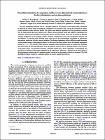| dc.contributor.author | Eastham, Paul | |
| dc.contributor.author | Bradley, Louise | |
| dc.contributor.author | Karanikolas, Vasilios D. | |
| dc.contributor.author | Marocico, Cristian A. | |
| dc.date.accessioned | 2020-03-10T15:03:17Z | |
| dc.date.available | 2020-03-10T15:03:17Z | |
| dc.date.issued | 2016 | |
| dc.date.submitted | 2016 | en |
| dc.identifier.citation | Karanikolas, V.D., Marocico, C.A., Eastham, P.R. & Bradley, A.L., Near-field relaxation of a quantum emitter to 2D semiconductors: surface dissipation and exciton polaritons, Physical Review B, 94, 2016 | en |
| dc.identifier.other | Y | |
| dc.identifier.uri | https://journals.aps.org/prb/abstract/10.1103/PhysRevB.94.195418 | |
| dc.identifier.uri | http://hdl.handle.net/2262/91750 | |
| dc.description | PUBLISHED | en |
| dc.description.abstract | The total spontaneous emission rate of a quantum emitter in the presence of an infinite MoS2 monolayer is enhanced by several orders of magnitude, compared to its free-space value, due to the excitation of surface exciton polariton modes and lossy modes. The spectral and distance dependence of the spontaneous emission rate are analyzed and the lossy surface wave, surface exciton polariton mode and radiative contributions are identified. The transverse magnetic and transverse electric exciton polariton modes can be excited for different emission frequencies of the quantum emitter, and their contributions to the total spontaneous emission rate are different. To calculate these different decay rates we use the non-Hermitian description of light-matter interactions, employing a Green's tensor formalism. The distance dependence follows different trends depending on the emission energy of the quantum emitter. For the case of the lossy surface waves, the distance dependence follows a z−n,n=2,3,4, trend. When transverse magnetic exciton polariton modes are excited, they dominate and characterize the distance dependence of the spontaneous emission rate of a quantum emitter in the presence of the MoS2 layers. The interaction between a quantum emitter and a MoS2 superlattice is investigated, and we observe a splitting of the modes supported by the superlattice. Moreover, a blueshift of the peak values of the spontaneous emission rate of a quantum emitter is observed as the number of layers is increased. The field distribution profiles, created by a quantum emitter, are used to explain this behavior. | en |
| dc.format.extent | 195418 | en |
| dc.language.iso | en | en |
| dc.relation.ispartofseries | Physical Review B; | |
| dc.relation.ispartofseries | 94; | |
| dc.rights | Y | en |
| dc.subject | Density of states | en |
| dc.subject | Exciton polariton | en |
| dc.subject | Excitons | en |
| dc.subject | Luminescence | en |
| dc.subject | Quantum optics | en |
| dc.subject | Spontaneous emission | en |
| dc.subject | 2-dimensional systems | en |
| dc.subject | Green's function methods | en |
| dc.title | Near-field relaxation of a quantum emitter to 2D semiconductors: surface dissipation and exciton polaritons | en |
| dc.type | Journal Article | en |
| dc.contributor.sponsor | Science Foundation Ireland (SFI) | en |
| dc.type.supercollection | scholarly_publications | en |
| dc.type.supercollection | refereed_publications | en |
| dc.identifier.peoplefinderurl | http://people.tcd.ie/easthamp | |
| dc.identifier.peoplefinderurl | http://people.tcd.ie/bradlel | |
| dc.identifier.rssinternalid | 146098 | |
| dc.identifier.doi | http://dx.doi.org/10.1103/PhysRevB.94.195418 | |
| dc.rights.ecaccessrights | openAccess | |
| dc.contributor.sponsorGrantNumber | 10/IN.1/12975 | en |
| dc.subject.TCDTheme | Nanoscience & Materials | en |
| dc.subject.TCDTag | ENERGY-TRANSFER | en |
| dc.subject.TCDTag | EXCITONS | en |
| dc.subject.TCDTag | FLUORESCENCE ENERGY-TRANSFER | en |
| dc.subject.TCDTag | Nano-Materials | en |
| dc.subject.TCDTag | QUANTUM CONFINEMENT | en |
| dc.subject.TCDTag | QUANTUM DOTS | en |
| dc.subject.TCDTag | QUANTUM EFFICIENCY | en |
| dc.subject.TCDTag | Semiconductor physics and technologies | en |
| dc.identifier.orcid_id | 0000-0002-7054-1457 | |
| dc.status.accessible | N | en |




